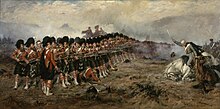Kadikoi: Difference between revisions
Biggleswiki (talk | contribs) Added detail on Thresher & Glenny's outpost established in 1854 for handling parcels to men on the front, with link to new article: 'Thresher & Glenny' |
Biggleswiki (talk | contribs) m Added reflist |
||
| Line 14: | Line 14: | ||
{{coord missing|Ukraine}} |
{{coord missing|Ukraine}} |
||
==References== |
|||
{{Reflist}} |
|||
[[Category:Geography_of_Ukraine]] |
[[Category:Geography_of_Ukraine]] |
||
Revision as of 13:16, 8 August 2011
Kadikoi (Crimean Tatar: Qadıköy, Russian: Кадыкой) in the 19th century was a village on the Crimean peninsula, in Ukraine, about 1 mile north of Balaklava. The Battle of Balaclava (also known as the Battle of Kadikoi to Russian historians) was fought on the hills and valleys to the north of Kadikoi in 1854. The village was later known as Kadykovka (Кадыковка), and Pryhorodne (Пригородне). Currently it's merged into Balaklava city, and is known as microdistrict Kadykovka. Its original Crimean Tatar name means literally "village of a judge" (qadı - judge, köy - village).

The British Army built a stationary engine on a hillside near the village, to up haul trains carrying men and materiel.
According to the Westminster City Archives, in 1854 the London tailor and shirt maker Thresher & Glenny established an agency an outpost "between Balaklava and the Camp", for the "safe custody and punctual delivery" of parcels to the Army.[1]
Another hill, slightly to the north and east of Kadikoi, was defended by six companies of the 93rd (Highland) Regiment (the Sutherland Highlanders, around 600 soldiers), a Turkish battalion (around 1,000 soldiers), and a six-gun battery of field artillery. The hill was attacked by a large forge of Russian cavalry on 25 October 1854, but repulsed by the British "Thin Red Line". The Heavy Brigade charged the stalled Russian cavalry in the South Valley slightly to the north, followed later by the charge of the Light Brigade in the North Valley, a few miles further north.
References
- ^ Westminster City Archives, St Ann’s Street, SW1, ref 301/27/1
